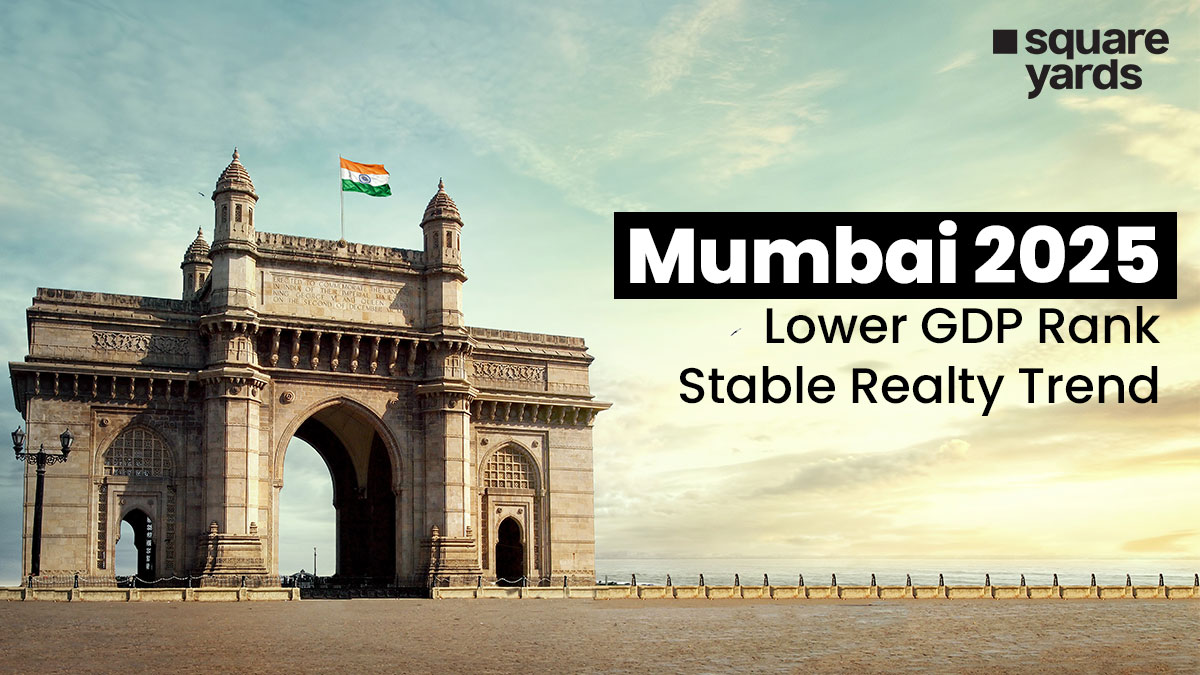The latest 2025 GDP per capita figures for Mumbai place the city lower on the ranking table than before. The city is currently in 9th place in the same table. The change in the rank of Mumbai's GDP per capita drew attention quickly. This is because Mumbai still carries the tag of India’s financial capital, so any shift in its position feels larger than the number itself. At the same time, the Mumbai real estate market in 2025 is telling a different story. Sales have stayed stable for a long time, and launch activity has not thinned out. Families are still booking homes across the western and central belts, and developers are opening new phases when they see demand. Mumbai has seen this kind of mismatch before. The charts move one way; the daily property transactions do something else.
Table of contents
- Mumbai's GDP Numbers Are Real, But It Is Not the Full Story
- Financial Ca pital, With a More Measured Profile
- The Micro-Markets That Tell the Real Story
- Navi Mumbai’s Momentum: The City Within the City
- Why the Mumbai GDP Math Looks Different on the Ground
- Mumbai GDP in 2025: The Same Foot Traffic, Just Better Infrastructure
- Frequently Asked Questions
Mumbai's GDP Numbers Are Real, But It Is Not the Full Story
The updated list confirms a drop in the GDP per capita of Mumbai for 2025. Growth has been slower, and the shift is visible in most official comparisons. Even so, property activity through the year has not followed that curve. April recorded a little above 12,000 registrations, and July crossed 12,300. Stamp duty collections for that month came close to ₹1,100 crore. These are not the signals of a city stepping back from buying.
A lot of the gap comes from how work is spread out now. Old factory jobs have now been reduced. In their place, you see finance, tech, design, logistics, media and many other service jobs growing across the region. These jobs continue to anchor households within the metro. That shows up quietly in home loan disbursements, weekday site visits, and the pace at which developers fill early inventory. The slope in the GDP chart is real, but it doesn’t reflect the full activity running through the wider urban belt.
Financial Capital, With a More Measured Profile
Mumbai has held its place as India’s financial capital for a long time, and that position has not shifted because of the recent GDP per capita ranking. The core of the city’s economy still runs through banking, capital markets, insurance, consulting, and the wider service ecosystem that supports them. These activities remain concentrated in the southern and central business districts. Also, a growing share is visible in BKC and most western areas.
Trading desks, corporate floors, and back-office units continue to operate through extended hours. That steady employment cycle keeps demand alive across mid and upper segments, especially for flats in Mumbai located near established commercial belts. The financial and service economy holds firm, though the effect appears slowly rather than in sudden jumps.
Global cities often go through phases in which headline growth tapers while the underlying economic base broadens. Currently, Mumbai is in that period. The Mumbai real estate market 2025 shows it in quieter ways. Homes are still being chosen, prices are moving but not sharply, and most choices now start with commute and access. Buyers negotiate more; they have not walked away. A large part of the demand is from people who plan to live in these homes, not to sell them afterwards.
The Micro-Markets That Tell the Real Story
Mumbai’s citywide averages often hide how differently its neighbourhoods move. The Mumbai real estate market is shaped more by individual pockets than by a single headline number, and activity across these pockets has remained steady.
- In Andheri West, Mumbai, rates are generally around ₹29,000 to ₹30,000 per sq ft in active buildings. Properties near workplace areas or reliable social infrastructure sell out in a short period of time. Most buyers here, like working professionals, look for a place that can reduce their travel time rather than entering the market as beginners.
- Borivali West, Mumbai, has its own speed when it comes to development. Property rates here are mostly between ₹19,000 and ₹28,000 per sq ft. These rates depend on the building and its age. Most buyers stay within the area, shifting from one place to another, looking for more space or newer amenities. The pattern here is steady, not a rush for short-term profit.
- Malad West, Mumbai, Maharashtra, and Kandivali East, Mumbai, show more movement. Malad’s offices and malls have drawn people in, and a few buildings have seen noticeable price jumps over the past year. Kandivali keeps a regular mid-segment crowd because it connects cleanly to major job routes and still feels manageable during the weekday. Projects here usually find buyers without much hustle.
- Bandra East, Mumbai, has changed shape over the past few years. What was once a weekday office belt is now a mixed-use area with premium homes, branded residences, and new office towers sharing the same grid. Buyers who want proximity to BKC but prefer newer stock often look here first.
Across these locations, the pattern is consistent. Volumes may shift month to month, but the underlying demand is intact. Decisions are tied to commute, schools, and project quality, not to month-on-month movements in the GDP table.
Navi Mumbai’s Momentum: The City Within the City
The role of Navi Mumbai in the wider region has become clearer in recent years. It no longer works only as a lower-cost alternative. Many parts of the planned city now operate as independent centres with their own commercial belts, housing belts, and civic networks. Interest in Navi Mumbai, Maharashtra, property has grown because the basic services here tend to run on predictable schedules, and that consistency matters to many households.
The Atal Setu (MTHL) has already shortened travel time between the island city and the mainland. The upcoming Navi Mumbai International Airport is shaping expectations in the nodes around Ulwe, Panvel, and the adjoining belts. Businesses planning for the long term are factoring in the airport catchment zone in advance, as evidenced by the spread of commercial and industrial activity in this part of the region.
Belapur benefits from wide arterial roads and administrative presence. Nerul has stable utilities and an established social grid. Panvel is an important place for road and rail connections. New metro lines are under development and expected to connect Belapur, Nerul, Taloja, and Panvel more tightly.
Developers are building at a steady pace in Kharghar, Ulwe, and parts of Panvel. Commercial parks around Taloja and the main areas are also expanding. Land auctions in recent rounds saw strong interest, which suggests that capital is aligned with the region’s long-term potential. For many buyers, choosing Mumbai now includes a natural look across the creek, not as an exception but as part of the decision-making routine.
Why the Mumbai GDP Math Looks Different on the Ground
To understand the shift in Mumbai’s rank, it helps to see how other districts have moved ahead this year. The updated Economic Survey highlights a few centres that have grown faster and now sit above Mumbai on the GDP per capita list.
|
District / City |
GDP per Capita (₹ lakh) |
What’s Driving It |
|
Rangareddy, Telangana |
11.46 |
IT, biotech and pharma expansion |
|
Gurugram, Haryana |
9.05 |
Corporate services and new-age enterprises |
|
Bengaluru Urban, Karnataka |
8.93 |
Technology-led output and services |
|
Mumbai, Maharashtra |
6.57 |
Output spread across MMR regions |
The drop in the Mumbai GDP 2025 table is mainly a data result. To understand why, we have to look at how the number is calculated: Total Economic Output divided by Total Population. Currently, the "numerator" (economic output) is shifting. A significant portion of the service economy and industrial production is now being logged in Thane and Navi Mumbai. However, the "denominator" (the population of Mumbai) has not decreased. That change alone can affect the GDP per capita of Mumbai directly. For property, the important question is whether the combined region continues to support income, employment, and credit availability. Through 2025, those factors have stayed steady. Registrations remain high, loan disbursals are healthy, and developers are releasing phases across categories.
Daily activity in registration offices still shows a constant line of buyers. Developers in both the city and its extended belts continue to launch residential projects in Mumbai and adjoining micro-markets with measured confidence. Banks and housing finance companies remain active across the salaried and self-employed segments. The statistical adjustment is real, but it reflects the spread of activity across the region, not a withdrawal of economic strength from the city.
Mumbai GDP in 2025: The Same Foot Traffic, Just Better Infrastructure
Pace is not the most significant change in Mumbai, but how the city is connected together. For instance, the Atal Setu (MTHL) now links the island city to the mainland. This makes the parts of the distant region feel realistic for daily commutes. New metro lines have brought east and west corridors closer together. Locations that were earlier outside most home search shortlists now sit inside a regular office-home-school triangle. This is visible in property investment in Mumbai, especially in mid and upper-mid projects near existing or announced stations.
The upcoming Navi Mumbai International Airport adds another layer. It is already influencing how buyers compare city addresses with options on the other side of the creek. Jobs linked to aviation, logistics, and services will sit around that hub, and housing is moving in advance. For the Mumbai real estate market in 2025, connectivity is doing more of the heavy lifting.
Frequently Asked Questions
Why did Mumbai’s GDP rank fall in 2025?
A lot of service activity now sits in Thane and Navi Mumbai, so the output is split between the two. Once that shift shows up in the tables, the GDP per capita of Mumbai drops even though the wider region hasn’t slowed.
Does a lower GDP rank affect Mumbai’s property market?
No, it does not affect the property market in any clear way so far. Property registrations and launches in the Mumbai real estate market in 2025 have remained steady. Also, buyers still move on jobs and commute basis, not the rank.
Are there any areas in Mumbai that are performing well in real estate in 2025?
Demand for properties holds in Borivali West, Andheri West, Kandivali East, and Malad West. Bandra East, Mumbai, stays mostly active as well. Some buyers now compare these with options in Navi Mumbai as connectivity improves.
Is Navi Mumbai contributing to Mumbai’s overall growth?
Yes, Navi Mumbai adds scale to Mumbai’s vast infrastructure. The Atal Setu helps movement, and the Navi Mumbai International Airport is pulling interest towards Ulwe and Panvel. Stable civic services in places like Nerul and Belapur also support this increase in interest.
Should I still invest in Mumbai real estate?
If you are a long-term buyer, then yes. Property investment in Mumbai still works because job centres are still strong. You can choose from older housing societies in Mumbai to newer options in Navi Mumbai.




